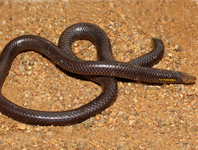Abstract
A new species, Amolops wenshanensis sp. nov., is described from Guangxi and Yunnan Provinces, China. The new species is a member of the A. monticola group, and is distinguished from its congeners using morphological and molecular data. The new species is diagnosed by having glandular dorsolateral folds; smooth skin; side of head dark with a light-colored upper lip stripe extending to axilla; green dorsal coloration in life; immaculate venter; indistinct transverse bands on dorsal surfaces of limbs; tympanum distinct; pineal body absent; all fingertips expanded with circummarginal grooves; two oblique vomerine teeth; vocal sac and white nuptial pad present in males; supratympanic fold absent; outer metatarsal tubercle absent; glandular gold-white flank spot absent; and skin on venter not translucent. A molecular phylogenetic analysis is performed using the mitochondrial (mt) NADH dehydrogenase subunit 2 (ND2) gene and parts of flanking tRNA genes for nine of the 15 members of the A. monticola group with available homologous sequences. The new species is sister to a clade containing A. cucae and A. compotrix, two species known from adjacent parts of Vietnam and Laos. The new species differs from its congeners by having an uncorrected p-distance of > 6.7% in the mt DNA fragment examined. At present, the new species is known from small, montane streams near Wenshan, Yunnan Province, and Jingxi, Guangxi Province, China.
References
AmphibiaWeb (2017) Information on amphibian biology and conservation. AmphibiaWeb, Berkeley, California. Available from: http://amphibiaweb.org/ (accessed 10 March 2017)
Anderson, J. (1871) A list of the reptilian accession to the Indian Museum, Calcutta from 1865 to 1870, with a description of some new species. Journal of the Asiatic Society of Bengal, 40, 12–39.
Annandale, N. (1912) Zoological results of the Abor expedition. Part I. Batrachia. Records of the Indian Museum, 8, 7–36.
https://doi.org/10.5962/bhl.part.1186Bain, R.H. & Nguyen, Q.T. (2004) Herpetofaunal diversity of Ha Giang Province in northeastern Vietnam, with descriptions of two new species. American Museum Novitates, 3453, 1–42.
https://doi.org/10.1206/0003-0082(2004)453%3C0001:HDOHGP%3E2.0.CO;2Bain, R.H., Lathrop, A., Murphy, R.W., Orlov, N.L. & Ho, T.C. (2003) Cryptic species of a cascade frog from southeast Asia: taxonomic revisions and descriptions of six new species. American Museum Novitates, 3417, 1–60.
https://doi.org/10.1206/0003-0082(2003)417%3C0001:CSOACF%3E2.0.CO;2Bain, R.H., Stuart, B.L. & Orlov, N.L. (2006) Three new Indochinese species of cascade frogs (Amphibia: Ranidae) allied to Rana archotaphus. Copeia, 2006, 43–59.
https://doi.org/10.1643/0045-8511(2006)006[0043:TNISOC]2.0.CO;2Cope, E.D. (1865) Sketch of the primary groups of Batrachia Salientia. Natural History Review, New Series, 5, 97–120.
Darriba, D., Taboada, G.L., Doallo, R. & Posada, D. (2012) JModelTest 2: more models, new heuristics and parallel computing. Nature Methods, 9, 772.
https://doi.org/10.1038/nmeth.2109Dong, B.J., Rao, D.Q. & Lu, S.Q. (2005) Amolops aniqiaoensis. In: Zhao, W.-G., Rao, D.Q., Lu, S.Q. & Dong, B.J. (Eds.), Herpetological surveys of Xizang autonomous region. 2. Medog. Sichuan Journal of Zoology, 24, p. 251. [in Chinese]
Fei, L., Hu, S.Q., Ye, C.Y. & Huang, Y.Z. (2009) Fauna Sinica. Amphibia. Vol. Anura. Science Press, Beijing, 957 pp.
Frost, D.R. (2017) Amphibian species of the world: An Online Reference, version 6.0. American Museum of Natural History, New York. Available from: http://research.amnh.org/herpetology/amphibia/index.php/ (accessed 10 March 2017)
Inger, R.F. & Charnard, T. (1997) A new species of ranid frog from Thailand, with comments on Rana livida (Blyth). Natural History Bulletin of the Siam Society, 45, 65–70.
Jiang, K., Wang, K., Yan, F., Xie, J., Zou, D.H., Liu, W.L., Jiang, J.P., Li, C. & Che, J. (2016) A new species of the genus Amolops (Amphibia: Ranidae) from southeastern Tibet, China. Zoological Research, 37 (1), 31–40.
Liu, W.Z., Yang, D.T., Ferraris, C. & Matsui, M. (2000) Amolops bellulus: A new species of stream-breeding frog from western Yunnan, China (Anura: Ranidae). Copeia, 2000 (2), 535–541.
https://doi.org/10.1643/0045-8511(2000)000[0536:ABANSO]2.0.CO;2Katoh, K. & Standley, D.M. (2013) MAFFT multiple sequence alignment software. Version 7. Improvements in performance and usability. Molecular Biology and Evolution, 30, 772–780.
https://doi.org/10.1093/molbev/mst010Miller, M.A., Pfeiffer, W. & Schwartz, T. (2010) Creating the CIPRES Science Gateway for inference of large phylogenetic trees. Gateway Computing Environments Workshop (GCE), IEEE, 2010, pp. 1–8.
https://doi.org/10.1109/GCE.2010.5676129Pope, C.H. (1929) Four new frogs from Fukien Province, China. American Museum Novitates, 352, 1–5.
Ray, P. (1992) Two new hill-stream frogs of the genus Amolops Cope (Amphibia: Anura: Ranidae) from Uttar Pradesh (India). Indian Journal of Forestry, 15, 346–350.
Ronquist, F., Teslenko, M., van der Mark, P., Ayres, D.L., Darling, A., Höhna, S., Larget, B., Liu, L., Suchard, M.A. & Huelsenbeck, J.P. (2012) MrBayes 3.2: efficient Bayesian phylogenetic inference and model choice across a large mod space. Systematic Biology, 61, 539–542.
https://doi.org/10.1093/sysbio/sys029Stamatakis, A. (2014) RAxML Version 8: a tool for phylogenetic analysis and postanalysis of large phylogenies. Bioinformatics, 30, 1312–1313.
https://doi.org/10.1093/bioinformatics/btu033Tamura, K., Stecher, G., Peterson, D., Filipski, A. & Kumar, S. (2013) MEGA6: molecular evolutionary genetics analysis version 6.0. Molecular Biology and Evolution, 30, 2725–2729.
https://doi.org/10.1093/molbev/mst197Stuart, B.L. (2008) The phylogenetic problem of Huia (Amphibia: Ranidae). Molecular Phylogenetics and Evolution, 46, 49–60.
https://doi.org/10.1016/j.ympev.2007.09.016Stuart, B.L., Inger, R.F. & Voris, H.K. (2006) High level of cryptic species diversity revealed by sympatric lineages of Southeast Asian forest frogs. Biology Letters, 2, 470–474.
https://doi.org/10.1098/rsbl.2006.0505Stuart, B.L., Bain, R.H., Phimmachak, S. & Spence, K. (2010) Phylogenetic systematics of the Amolops monticola group (Amphibia: Ranidae), with description of a new species from northwestern Laos. Herpetologica, 66 (1), 52–66.
https://doi.org/10.1655/08-073.1Wu, G.F. & Tian W.S. (1995) A new Amolops species from southern Yunnan. Sichuan Journal of Zoology, Supplement, Herpetological Series, 8, 50–52. [in Chinese]
Wilgenbusch, J.C., Warren, D.L. & Swofford, D.L. (2004) AWTY: A system for graphical exploration of MCMC convergence in Bayesian phylogenetic inference. Available from: http://ceb.csit.fsu.edu/awty (accessed 14 March 2018)

